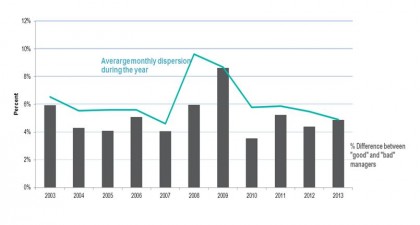The yield on the 10-year Treasury as measured by the S&P/BGCantor Current 10 Year U.S. Treasury Index suddenly moved higher to 2.78% from the previous day’s 2.64%. Thursday’s upward movement before the Good Friday Holiday was a result of negotiations over the Ukraine crisis possibly resulting in an accord to defuse the conflict.
Yields in the U.S. have remained lower as political tensions in Ukraine have kept Treasuries as the safety trade. In addition to global political issues, domestic indicators that measure the U.S. labor market have not shown a consistent amount of improvement.
This week’s economic calendar started with the Chicago Fed Activity Index coming as expected at a 0.2 and the U.S. Leading Index stronger than the expected 0.7% and the previous 0.5%, at a 0.8% for March. The week is full of reporting’s that will affect the bond markets and their indices. Tuesday kicks off the housing numbers with the FHFA House Price Index (0.5% expected), Existing Home Sales for March (4.55m expected) and the Richmond Fed Manufacturing Index (2 expected). Wednesday continues the housing and manufacturing theme as MBA Mortgage Applications, New Home Sales (450k) and the Markit US Manufacturing PMI (56 expected) are due. Later in the week Durable Goods Orders (2% expected), Initial Jobless Claims (313K expected), and the University of Michigan Confidence Survey (83 expected) close out the week.
The S&P U.S. Issued Investment Grade Corporate Bond Index is returning 0.6% month-to-date which is a much better start than all of March’s return of 0.04%. Thursday’s jump in Treasury yields was evident in corporates as well with the index giving up 0.37% in one day. Year-to-date the index has returned 3.52%.
The S&P U.S. Issued High Yield Corporate Bond Index is slightly behind the investment grades returning 0.3% for the month and 3.27% year-to-date. The spread to Treasuries of the high yield bonds is only slightly wider than from the beginning of the month. Presently the BB and single B indices are only slightly wider on the month while the S&P U.S. Issued CCC & Lower High Yield Corporate Bond Index is 29 basis points wider.
One of the big headlines last week was TIAA-CREF’s $6.25 billion acquisition of Nuveen Investments. The single B rated term loan B-structure issued by Nuveen Investments Inc., holds a 1.15% weight in the S&P/LSTA U.S. Leveraged Loan 100 Index which returned 0.02% last week. Month-to-date this index is down-0.01% while returning only 1% year-to-date.
Source: S&P Dow Jones Indices, Data as of 4/17/2014, Leveraged Loan data as of 4/20/2014.
The posts on this blog are opinions, not advice. Please read our Disclaimers.















































